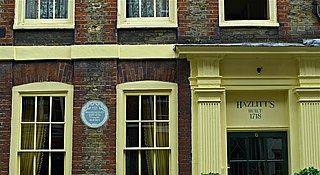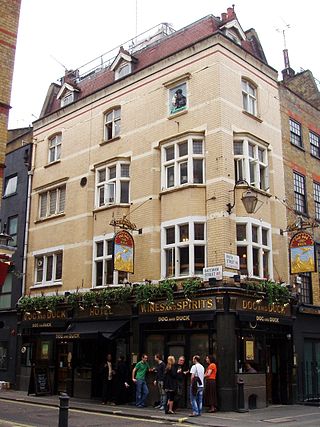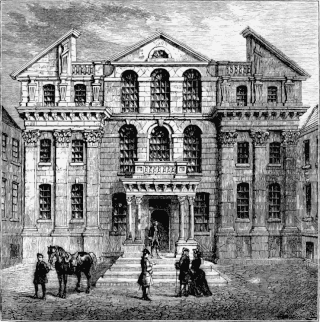
Scotland Yard is the headquarters of the Metropolitan Police, the territorial police force responsible for policing Greater London's 32 boroughs. Its name derives from the location of the original Metropolitan Police headquarters at 4 Whitehall Place, which had its main public entrance on the Westminster street called Great Scotland Yard. The Scotland Yard entrance became the public entrance, and over time "Scotland Yard" came to be used not only as the common name of the headquarters building, but also as a metonym for the Metropolitan Police Service (MPS) itself and police officers, especially detectives, who serve in it. The New York Times wrote in 1964 that, just as Wall Street gave its name to New York's financial district, Scotland Yard became the name for police activity in London.

Soho is an area of the City of Westminster, part of the West End of London. Originally a fashionable district for the aristocracy, it has been one of the main entertainment districts in the capital since the 19th century.

The Prospect of Whitby is a historic public house on the banks of the Thames at Wapping in the London Borough of Tower Hamlets. It lays claim to being the site of the oldest riverside tavern, dating from around 1520.

Soho Square is a garden square in Soho, London, hosting since 1954 a de facto public park let by the Soho Square Garden Committee to Westminster City Council. It was originally called King Square after Charles II, and a much weathered statue of the monarch has stood in the square, with an extended interruption, since 1661, one year after the restoration of the monarchy.

Dean Street is a street in Soho, central London, running from Oxford Street south to Shaftesbury Avenue. It crosses Old Compton Street and is linked to Frith Street by Bateman Street.

Frith Street is in the Soho area of London. To the north is Soho Square and to the south is Shaftesbury Avenue. The street crosses Old Compton Street, Bateman Street and Romilly Street.

The Great Synagogue of London was, for centuries, the centre of Ashkenazi synagogue and Jewish life in London. Built north of Aldgate in the 17th century, it was destroyed during World War II, in the Blitz.
Les Cousins was a folk and blues club in the basement of a restaurant in Greek Street, in the Soho district of London, England. It was most prominent during the British folk music revival of the mid-1960s and was known as a venue where musicians of the era met and learnt from each other. As such, it was influential in the careers of, for example, Jackson C. Frank, Al Stewart, Marc Brierley, Davey Graham, Bert Jansch, John Renbourn, Sandy Denny, John Martyn, Alexis Korner, The Strawbs, Roy Harper, The Young Tradition and Paul Simon. Several albums were recorded there.

St Patrick's Church is a large Roman Catholic parish church in Soho Square, London. St Pat's was consecrated as a chapel in a building behind Carlisle House on 29 September 1792, one of the first Catholic buildings allowed in Great Britain after the Reformation.
Wolfgang Amadeus Mozart composed six sonatas for keyboard with accompaniment of violin and cello, K. 10–15, in late 1764 in London during the Mozart family's grand tour of Europe. Queen Charlotte commissioned them on 25 October, and the works were dedicated to her on 18 January 1765. They were published as Mozart's "Opus III" by his father Leopold at 20 Frith Street, Soho, London, where the Mozarts lived from September 1764 until after May 1765.

Comptons of Soho is a gay pub in London. Situated at 51–53 Old Compton Street in the heart of Soho's 'Gay village', Comptons has been an integral part of London's gay scene since June 1986.

Quo Vadis is a restaurant and private club in Soho, London. It primarily serves modern British food. It was founded in 1926 by Peppino Leoni, an Italian, and has passed through numerous owners since then, including the chef Marco Pierre White, and is currently owned by Sam and Eddie Hart, also the owners of Barrafina. The restaurant is named after the Latin phrase Quo vadis?, meaning "Where are you going?"

Hazlitt's is a townhouse hotel located at 6 Frith Street, Soho, London, in very close proximity to Soho Theatre. The building is Georgian and dates back to 1718, four storeys, with typical long Georgian-bay windows painted in beige. Owned by Peter McKay and Douglas Blain, it is named after the essayist William Hazlitt who died in the house in 1830; he has a blue plaque on the wall to the left of the front door. Due to its heritage, the hotel is popular with writers, but also artists, ledges, actors and models. It was awarded the César Award for London Hotel of the Year by The Good Hotel Guide in 2002.
The London Noses or Seven Noses of Soho are an artistic installation found on buildings in London. They are plaster of Paris reproductions of the artist's nose which protrude from walls in an incongruous and unexpected way. They were created by artist Rick Buckley in 1997. Initially, about 35 were attached to buildings such as the National Gallery and Tate Britain but by 2011 only about 10 survived.

20 Frith Street is a building in the Soho district of London. It is located on the east side of Frith Street, close to the junction with Old Compton Street. The building which currently occupies the site of 20 Frith Street was built in 1858 by William Cooze to replace a house which dated from c1725, which itself may have replaced an even earlier building.

The Dog and Duck is a Grade II listed public house at 18 Bateman Street, Soho, London W1D 3AJ, built in 1897 by the architect Francis Chambers for Cannon Brewery.

The St James Workhouse opened in 1725 on Poland Street in the Soho area of London, England, in what was then the parish of Westminster St James, and continued well into the nineteenth century.

Monmouth House was a 17th-century mansion in Soho Square built for the Duke of Monmouth, the oldest illegitimate son of King Charles II. After the Duke's execution for attempting to lead a rebellion against the unpopular Catholic successor to Charles, James II, the house was owned by the Bateman family and loaned to various important people including the French ambassador before being demolished in 1773.

The Intrepid Fox was a pub at 97–99 Wardour Street, Soho, London, established in 1784 by the publican Samuel House, who named it after the prominent British Whig statesman Charles James Fox. The pub was located on the corner of Wardour Street and Peter Street.
















